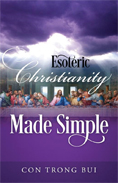
 |
Does being a faithful adherent of Christianity mean that one must accept apparent biblical fallacies and falsities as inspired truth? This is the central theme that has motivated author Bui to compose this lengthy treatise on biblical writings. His exploration begins appropriately in the first portion of Genesis, certainly one of the thorniest pieces of the scriptural puzzle, in which we seem meant to believe that before God created earth and heaven, he had no place to live. Though couched humorously, Bui’s suggestion is logical, a trend that will be seen throughout his narrative. Also, if Adam and Eve had no knowledge of good and evil before eating the forbidden fruit, how could their action be considered a sin? Bui explains that disobedience was the sin.
Bui postulates that there are “three adversaries” that human beings must overcome: sins of the flesh, basic human nature, and power in high places, or ego. As he meticulously parses certain pieces of scripture, he suggests that when Jesus told followers to take up their “cross” and follow him, he was not speaking of a wooden crucifix but the burden of the human body itself. The author distinguishes between “God” the creator and “Lord God” who walked among and interacted with mankind. Bui often illustrates human traits as related to “dust” and “tillage”: Adam was conceived in dust, and then, after eating from the forbidden tree, he would become a tiller of the soil and eventually return to that soil at his death. Bui examines the Eastern theory of reincarnation, suggesting while a soul does not literally go from one body to another, it can be reasonably considered that our souls, or tendencies, adhere to the newly born as personality traits. Such ideas are refreshing as well as thought-provoking.
The author, who has made a serious study of realms beyond the physical world, applies his extensive research here in a way that presents as a minute, painstaking analysis of the Bible, word by word. Readers may want to emulate his diligence by paying careful attention to how each detail fits into the totality of his thesis. He points out that those who composed scripture were, as well as conveying what knowledge they were privy to, also hoping to construct “a story that could appeal to everyone.” And in creating stories, they were also creating symbolism, and doing so in the idiom of their day. Undoubtedly, many sincere Christians have questioned the seeming contradictions and puzzling situations that fill the Holy Bible. Bui hopes to fill in some of the most obvious gaps and convey something of the reality behind the symbols.
Bui’s faith is grounded in the understanding that we have come from spirit, and to spirit we will return at the end of our journey. This is a hopeful outlook that will encourage as well as educate. The author has penned a well-written and intriguing book. The pensive seekers he undoubtedly envisions as a target readership will be free to take his perspective as both a solace and a challenge.
RECOMMENDED by the US Review